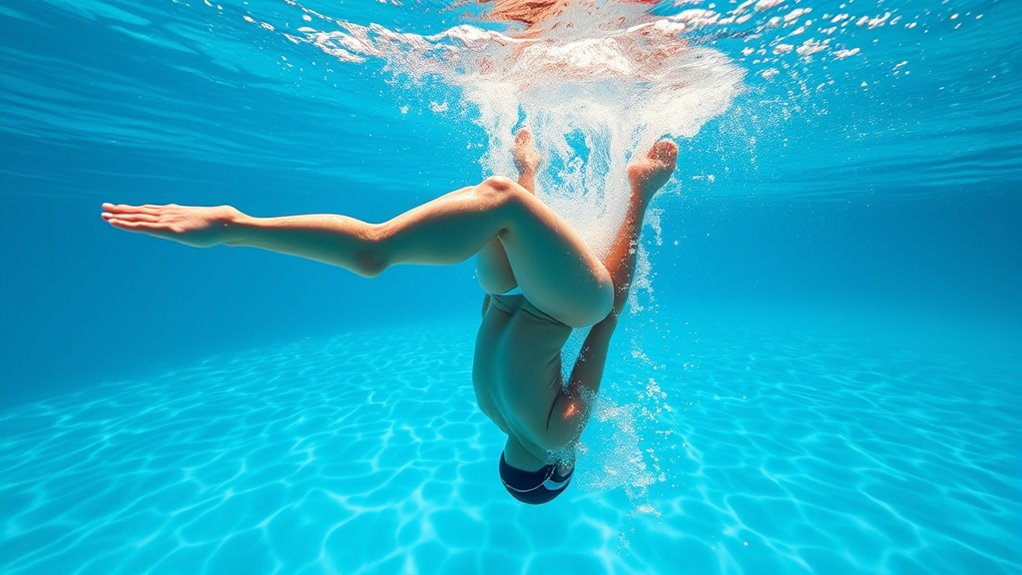Common flip turn errors include mistimed flips, poor body alignment, and weak push-offs, which slow you down and disrupt flow. To fix these issues quickly, focus on consistent breathing, practice streamline drills to tighten your posture, and break down the turn into manageable steps. Using targeted drills and feedback can boost your control and speed. Keep practicing your technique, and you’ll discover even more ways to perfect your flip turns.
Key Takeaways
- Focus on proper timing of the flip to ensure a smooth rotation and avoid losing momentum.
- Maintain tight body alignment and streamline position during and after the turn to reduce drag.
- Use rhythmic exhalation underwater approaching the wall to prevent panic and maintain control.
- Incorporate drills and video feedback to identify and correct form issues during the flip.
- Push off strongly with a tight streamline and avoid unnecessary movements to maximize speed and efficiency.

Have you ever wondered what makes a perfect flip turn in swimming? It’s a skill that combines timing, technique, and efficiency. To master it, you need to focus on key elements that can often trip you up, like breathing techniques and streamline drills. These components play a vital role in executing a smooth, fast flip turn, so understanding and practicing them can drastically improve your performance.
Breathing techniques are essential during the flip turn because they help maintain rhythm and prevent you from losing momentum. As you approach the wall, exhale steadily underwater to avoid holding your breath too long, which can cause panic or disorientation. Just before you execute the turn, take a quick, controlled breath to prepare for the push-off. Proper breathing ensures your body stays relaxed, reducing unnecessary drag and fatigue. If you find yourself gasping or holding your breath during the turn, you’re likely disrupting your flow, so focus on rhythmic exhalation and inhalation. Practicing rhythmic breathing drills outside of your normal swim sets can help ingrain this pattern, making it second nature during the flip turn. Additionally, being aware of your emotional state can help prevent anxiety from disrupting your breathing rhythm and overall performance.
Proper breathing during flip turns maintains rhythm, reduces drag, and keeps you relaxed underwater.
Streamline drills are equally vital because they help you maximize your glide after pushing off the wall. Once you complete the turn and push off, your goal is to minimize resistance and maintain a tight, streamlined position. Incorporate streamline drills into your training by focusing on body alignment, keeping your arms tight against your ears, and engaging your core muscles. These drills build muscle memory for a proper streamline, ensuring you stay in a straight line and reduce drag. Many swimmers make the mistake of losing their tight posture after the push-off, which slows them down. To fix this, practice holding your streamline position for extended periods and incorporate it into your flip turn routine. Over time, this will become second nature, enabling you to accelerate off the wall with minimal resistance.
Common errors include not timing the flip correctly, losing form during the turn, or failing to push off with enough force. Quick fixes involve refining your approach with targeted drills and mindfulness of your breathing. For example, when you’re practicing your flip, pause at the wall to check your body position and make small adjustments. Use video feedback if possible to identify where your form breaks down. Focus on maintaining a steady breathing pattern and executing streamline drills to reinforce proper body alignment. Ultimately, improving your flip turn requires deliberate practice of these fundamental skills, so stay consistent, and over time, your turns will become faster, cleaner, and more efficient.
Frequently Asked Questions
How Long Does It Typically Take to Master a Perfect Flip Turn?
Mastering a perfect flip turn varies based on your skill level and practice consistency. It generally takes several weeks to months to develop solid timing precision and smooth technique adjustments. You need regular practice, focusing on proper body positioning and rotation. With dedication and feedback, you’ll notice improvements faster. Stay patient, and over time, your flip turns will become more fluid and efficient, boosting your overall swimming performance.
Are There Specific Drills to Improve Flip Turn Speed?
Think of improving flip turn speed like tuning a car engine—you need precise adjustments. To boost your pace, try drill variations like fast flip turns and underwater dolphin kicks. Incorporate pace training by timing your turns and gradually increasing speed. Focus on consistency and smooth progressions. These targeted exercises help you develop better control and quickness, making your flip turns faster and more efficient over time.
Can Flip Turn Errors Vary by Swimming Stroke?
Yes, flip turn errors can vary by swimming stroke due to stroke-specific variations and technique adaptations. For example, freestyle flips emphasize streamlined body position, while butterfly turns require quick, powerful rotations. Understanding these differences helps you identify and correct stroke-specific mistakes. By focusing on technique adaptations for each stroke, you can improve your flip turn efficiency and reduce errors, ultimately enhancing your overall swimming performance.
What Are Common Injuries Related to Flip Turn Mistakes?
When you make flip turn mistakes, you risk injuries like shoulder strain and neck tension. Poor technique or abrupt movements can strain your shoulder muscles or cause tension in your neck from improper head positioning. To avoid these issues, focus on smooth, controlled turns, keep your head aligned, and engage your core. Proper form not only improves your flip turns but also helps prevent these common injuries.
How Do Competitive Swimmers Train for Flip Turn Consistency?
To train for flip turn consistency, you focus on perfecting your turn technique and flip timing. Practice drills that emphasize quick, controlled rotations and smooth pushes off the wall. Use video feedback to analyze your form and make adjustments. Incorporate interval training to build muscle memory, and work with coaches to refine your timing. Consistent drills and focused attention on these elements help you improve your flip turn reliability in races.
Conclusion
Just like a master painter corrects each stroke, refining your flip turn takes patience and practice. When you fix common errors, your momentum flows seamlessly, turning every wall into a chance to glide effortlessly forward. Remember, even the greatest swimmers once struggled with their turns—think of Michael Phelps perfecting each dive. Keep practicing, stay patient, and soon your flip turn will become as smooth as a wave, carrying you effortlessly through every lap.










